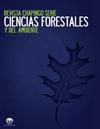椰子(Cocos nucifera L.)基因型捕获掌叶Rhynchophorus palarum L.的成本效益和种群波动
IF 0.6
4区 农林科学
Q3 Agricultural and Biological Sciences
Revista Chapingo Serie Ciencias Forestales Y Del Ambiente
Pub Date : 2022-08-30
DOI:10.5154/r.rchscfa.2022.02.010
引用次数: 0
摘要
简介:棕榈Rhynchophorus palmarum L.是墨西哥椰子树种植园最具破坏性的害虫。目的:评价两种不同基因型的椰子诱捕棕褐发菌的成本效益,并探讨诱捕效果与环境因素的相关性。材料与方法:用1年的时间,以“Alto Pacífico ecotipo 2”(AP)和“Enano-Verde de Brasil”(EVB)为基因型,捕获棕榈螟。采用了5种捕集器(BT =水桶型、TCT =垃圾桶型、GT =加仑型、CSAT =热带高等农业学院、BT =瓶型)。每周进行诱捕计数,并确定诱捕的成本效益。诱捕分析采用准泊松分布、偏差分析和最不显著差异分析。利用斯皮尔曼系数确定了捕集与气候变量的相关性。结果与讨论:AP共捕获昆虫3 414只,其中TCT和CSAT捕蝇效果最好(P < 0.014),分别占捕获成虫总数的40.3%和32.7%;成本效益最佳,分别为4.3 MXN /只和5.5 MXN /只。采用GT法捕获的昆虫数量为4 799只,是AP的3.56倍(29.6:6.4)。两个果园的气候变量与捕获的相关性均较弱(小于50%);相对湿度的相关性最高,但呈负相关。结论:诱捕器的效率及其成本效益将使养殖者能够决定使用哪种诱捕器对棕叶田鼠进行机械和行为(聚集信息素)控制本文章由计算机程序翻译,如有差异,请以英文原文为准。
Cost-benefit of trapping and population fluctuation of Rhynchophorus palmarum L. in coconut (Cocos nucifera L.) genotypes
Introduction: Rhynchophorus palmarum L. is the most destructive pest in Cocos nucifera plantations in Mexico. Objective: To estimate the cost-benefit of collecting R. palmarum by trapping in two coconut genotypes and to determine the correlation of trapping with environmental factors. Materials and methods: R. palmarum insects were captured on the genotypes ‘Alto Pacífico ecotipo 2’ (AP) and ‘Enano-Verde de Brasil’ (EVB) for one year. Five types of traps were used (BT = bucket type, TCT = trash can type, GT = gallon type, CSAT = Colegio Superior de Agricultura Tropical, BT = bottle type). Trapping was counted weekly, and the cost-benefit of trapping was determined. Trapping was analyzed with quasi-Poisson distribution, deviancy analysis and least significant difference. Trapping correlation with climate variables was determined with the Spearman’s coefficient. Results and discussion: A total of 3 414 insects were captured in AP. TCT and CSAT were the most effective (P < 0.014) with 40.3 % and 32.7 % of the total adults, respectively; they also had the best cost-benefit, 4.3 MXN and 5.5 MXN per insect, respectively. In EVB, 3.56 times more insects were captured (4 799) compared to AP with a 29.6:6.4 ratio, using GT. In both orchards, the correlations of climate variables with trapping were weak (less than 50 %); relative humidity was the most highly correlated, but negative. Conclusions: The efficiency of traps and their cost-benefit will allow growers to determine which trap to use for mechanical and ethological (aggregation pheromone) control of R. palmarum
求助全文
通过发布文献求助,成功后即可免费获取论文全文。
去求助
来源期刊
CiteScore
1.20
自引率
16.70%
发文量
0
审稿时长
>12 weeks
期刊介绍:
The Revista Chapingo Serie Ciencias Forestales y del Ambiente (RCHSCFA) is a scientific journal that aims to raise awareness of high-quality research products related to forest, arid, temperate and tropical environments in the world. Since its foundation in 1994, the RCHSCFA has served as a space for scientific dissemination and discussion at a national and international level among academics, researchers, undergraduate and graduate students, forest managers and public/private entities that are interested in the forest environment.
All content published in the journal first goes through a strict triple-blind review process and is published in the following formats: Scientific Articles, Review Articles, Methodologies, Technical or Technological Notes.

 求助内容:
求助内容: 应助结果提醒方式:
应助结果提醒方式:


